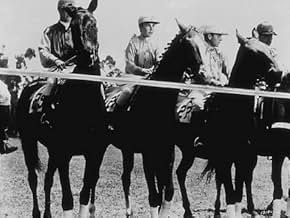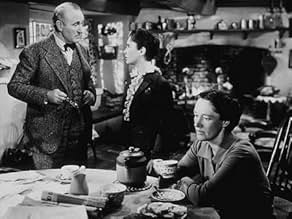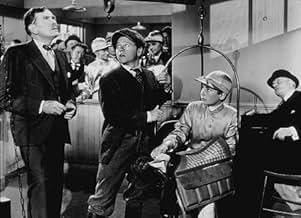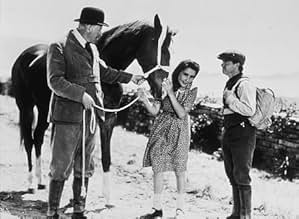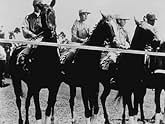IMDb RATING
7.3/10
8.5K
YOUR RATING
A jaded former jockey helps a young girl prepare a wild but gifted horse for England's Grand National Sweepstakes.A jaded former jockey helps a young girl prepare a wild but gifted horse for England's Grand National Sweepstakes.A jaded former jockey helps a young girl prepare a wild but gifted horse for England's Grand National Sweepstakes.
- Won 2 Oscars
- 6 wins & 5 nominations total
Jackie 'Butch' Jenkins
- Donald Brown
- (as Jackie Jenkins)
Featured reviews
Yes. Indeed! - Regardless of National Velvet now being 70 years old, this entertaining, heart-warming tale about trust, personal victory and following one's dream is, without a doubt, an endearing, MGM classic that can be enjoyed by the whole family.
With an excellent cast, headlined by Elizabeth Taylor (12 at the time), Mickey Rooney, and Anne Revere, National Velvet's story is a rather charming "horse tale" that jauntily crosses the finish line as a bona-fide winner.
This lush, Technicolor treat (which was adapted from Enid Bagnold's novel of the same name) was set in the 1920s (in England) in the rural, coastal county of Sussex.
A real stand-out performance in this first-rate picture was that of Anne Revere (who played Velvet's mother, Araminty Brown). Revere won an Oscar for her "Best Supporting Actress" role.
I certainly recommend National Velvet highly to anyone who truly enjoys a big, wholesome slice of vintage, Hollywood movie-making.
With an excellent cast, headlined by Elizabeth Taylor (12 at the time), Mickey Rooney, and Anne Revere, National Velvet's story is a rather charming "horse tale" that jauntily crosses the finish line as a bona-fide winner.
This lush, Technicolor treat (which was adapted from Enid Bagnold's novel of the same name) was set in the 1920s (in England) in the rural, coastal county of Sussex.
A real stand-out performance in this first-rate picture was that of Anne Revere (who played Velvet's mother, Araminty Brown). Revere won an Oscar for her "Best Supporting Actress" role.
I certainly recommend National Velvet highly to anyone who truly enjoys a big, wholesome slice of vintage, Hollywood movie-making.
"National Velvet" tells the story of Velvet Brown, a young English girl with dreams of entering her beloved horse into competition at the prestigious Grand National horse race. The film follows her as she trains her horse with the aid of a former jockey and the support of her parents.
While "National Velvet" is a family film that fact shouldn't deter anyone who typically views such films with derision. The film is indeed one that will appeal to the entire family, not just attention-addled youngsters. It even managed to land five Oscar nominations, hardly a sign of slacking off for a general audience.
Anne Revere, in the part of Velvet's mother, actually won an Oscar for her performance. She was indeed excellent in the role but it is 12-year old Elizabeth Taylor who steals the show. She is a charming presence and exhibits a talent beyond her years. Also on board is Oscar-winner Donald Crisp as Velvet's father, Mickey Rooney as former jockey Mi Taylor and Angela Lansbury (in one of her earliest film roles) as Velvet's older sister.
The film's lustrous Technicolor makes for an attractive viewing experience while the editing secured the second of the film's two Oscars. Additionally, the film was nominated for its direction (by Clarence Brown), cinematography & art direction. The score by ten-time Oscar nominee Herbert Stothart is also worth mentioning, though it went unnominated.
All in all, "National Velvet" is a wonderful family film that deserves a higher rating. I realize that the prospect of watching a film about a girl and her horse isn't exactly going to thrill some people but this one is worth taking a chance on.
While "National Velvet" is a family film that fact shouldn't deter anyone who typically views such films with derision. The film is indeed one that will appeal to the entire family, not just attention-addled youngsters. It even managed to land five Oscar nominations, hardly a sign of slacking off for a general audience.
Anne Revere, in the part of Velvet's mother, actually won an Oscar for her performance. She was indeed excellent in the role but it is 12-year old Elizabeth Taylor who steals the show. She is a charming presence and exhibits a talent beyond her years. Also on board is Oscar-winner Donald Crisp as Velvet's father, Mickey Rooney as former jockey Mi Taylor and Angela Lansbury (in one of her earliest film roles) as Velvet's older sister.
The film's lustrous Technicolor makes for an attractive viewing experience while the editing secured the second of the film's two Oscars. Additionally, the film was nominated for its direction (by Clarence Brown), cinematography & art direction. The score by ten-time Oscar nominee Herbert Stothart is also worth mentioning, though it went unnominated.
All in all, "National Velvet" is a wonderful family film that deserves a higher rating. I realize that the prospect of watching a film about a girl and her horse isn't exactly going to thrill some people but this one is worth taking a chance on.
I watched National Velvet ages ago, before Elizabeth Taylor ( who plays the jockey) befriended Michael Jackson. Anyway, I remembered this movie because of Rachael Blackmore's historic achievement in 2021 to be the first woman to win the Grand National. Art and life and all that, well done to everyone.
If you last saw National Velvet with a Saturday matinée serial, for a ticket price of twenty-five cents (including popcorn) -- and you purchased the video to see it again with family -- be prepared to re-experience primal feelings from the early dawn of your history. Warm, wet tears will run down your cheeks. Warm, happy feelings will make you stand up and cheer, as if the posse were galloping to the rescue; but most of all, you will feel good -- it will happen often while viewing National Velvet. See the video many times -- cry and use a handkerchief (remember that piece of cloth mom tucked into your shirt pocket) -- jump up from the sofa and cheer; and FEEL GOOD again -- and again.
National Velvet was initially released in 1944; but I must have seen a re-release soon thereafter -- because I know that I was in grade school at the time. I did not see it again until I bought the DVD for my mother recently. And if asked what the movie was about, during that interim period of more than fifty years, I would have answered -- "it's about a horse." That's a boy's initial and lasting impression.
Animal lovers, (I'm sorry, but) National Velvet is not a horsey movie (and never has been)-- the film is really about the pre-teen innocence and enthusiasm of Velvet Brown (Elizabeth Taylor). No animal -- not the film's sorrel gelding, nor Charlie, my yellow labrador -- can compete with the budding beauty of Elizabeth Taylor for the camera's attention. But, stay focused on Velvet's three interwoven relationships -- with Mi Taylor (Mickey Rooney), with her mother (Anne Revere, best supporting actress Academy Award), and the horse, Pirate ("Pi"). What characterizes winsome Velvet, in these attachments, is a 12-year old's single mindedness of commitment and trust, together with her unwaivering loyalty -- admirable qualities also of Ms. Taylor in real life. Mi, whose father mentored Mrs. Brown, is a young itinerant from less fortunate circumstances, with a working knowledge of jumping horses. Mrs. Brown, ever mindful of her own growing experiences, is especially supportive of both her daughter and Mi. The spirited Pi is difficult handling for its owner, and the horse soon becomes a project for Mi and Velvet.
Angela Lansbury (Velvet's older sister, Edwina, aka TV's Jessica Fletcher fifty years later), Jackie Jenkins (the young brother), and particularly Donald Crisp (Mr. Brown, Velvet's father and village butcher) provide able and entertaining support roles. National Velvet received five Academy nominations, winning two.
Set in the 1920's English coastal village of Sewels and its green pasturelands (on location in Carmel, California), Enid Bagnold's book (1933)and the film (1944) tell us a lot about the moral and social structure of small villages (and our small towns, too). One meaningful scene shows Mrs. Brown stowing money in a kitchen pot on her pantry shelf, while Mi spies from the window -- we are wary of what he might do next. Villagers could be suspicious of strangers but they also extended trust, believing in a person's goodness. Front doors were left open -- grandparents will tell of neighbors regularly walking into an empty house, through the unlatched screen, to borrow a cup of sugar from the same cupboard where family monies were stored (my mother kept petty cash in an unused sugar bowl). Honesty was important, but entrusting friends and neighbors was equally valued. That unlatched screen with open front door was a symbol of our neighborliness and trust, and a more meaningful symbol of the times we lived in -- and yes, maybe it said something about our innocence too.
National Velvet was initially released in 1944; but I must have seen a re-release soon thereafter -- because I know that I was in grade school at the time. I did not see it again until I bought the DVD for my mother recently. And if asked what the movie was about, during that interim period of more than fifty years, I would have answered -- "it's about a horse." That's a boy's initial and lasting impression.
Animal lovers, (I'm sorry, but) National Velvet is not a horsey movie (and never has been)-- the film is really about the pre-teen innocence and enthusiasm of Velvet Brown (Elizabeth Taylor). No animal -- not the film's sorrel gelding, nor Charlie, my yellow labrador -- can compete with the budding beauty of Elizabeth Taylor for the camera's attention. But, stay focused on Velvet's three interwoven relationships -- with Mi Taylor (Mickey Rooney), with her mother (Anne Revere, best supporting actress Academy Award), and the horse, Pirate ("Pi"). What characterizes winsome Velvet, in these attachments, is a 12-year old's single mindedness of commitment and trust, together with her unwaivering loyalty -- admirable qualities also of Ms. Taylor in real life. Mi, whose father mentored Mrs. Brown, is a young itinerant from less fortunate circumstances, with a working knowledge of jumping horses. Mrs. Brown, ever mindful of her own growing experiences, is especially supportive of both her daughter and Mi. The spirited Pi is difficult handling for its owner, and the horse soon becomes a project for Mi and Velvet.
Angela Lansbury (Velvet's older sister, Edwina, aka TV's Jessica Fletcher fifty years later), Jackie Jenkins (the young brother), and particularly Donald Crisp (Mr. Brown, Velvet's father and village butcher) provide able and entertaining support roles. National Velvet received five Academy nominations, winning two.
Set in the 1920's English coastal village of Sewels and its green pasturelands (on location in Carmel, California), Enid Bagnold's book (1933)and the film (1944) tell us a lot about the moral and social structure of small villages (and our small towns, too). One meaningful scene shows Mrs. Brown stowing money in a kitchen pot on her pantry shelf, while Mi spies from the window -- we are wary of what he might do next. Villagers could be suspicious of strangers but they also extended trust, believing in a person's goodness. Front doors were left open -- grandparents will tell of neighbors regularly walking into an empty house, through the unlatched screen, to borrow a cup of sugar from the same cupboard where family monies were stored (my mother kept petty cash in an unused sugar bowl). Honesty was important, but entrusting friends and neighbors was equally valued. That unlatched screen with open front door was a symbol of our neighborliness and trust, and a more meaningful symbol of the times we lived in -- and yes, maybe it said something about our innocence too.
There's a family that enjoys the life it lives (on the south coast on England, late 1920s), that takes in a wayward traveller to give, sustenance and shelter, he becomes the father's helper (delivery boy), and it soon turns out he has much more to give; as he makes a friend of Velvet who desires, and together they combine, devise, conspire, to acquire a race horse (steeplechaser), there's some luck involved of course, although the father is displeased and shows some ire (not for too long though); the said horse is called The Pie and he can fly, jumping obstacles of scale he does not shy, gets a chance to race Grand National, jockey change leads to fantastical, in a beauty of a film, might make you cry.
Did you know
- TriviaMickey Rooney had to film all of his scenes in one month before he had to report for basic training to serve in World War II.
- GoofsThe horses are shown turning right at one point during the race. All turns on the Grand National course are made to the left.
- Quotes
Mrs. Brown: That'll be a dispute to the end of time, Mr. Brown: whether it's better to do the right thing for the wrong reason or the wrong thing for the right reason.
- Crazy creditsA frame, with music, was added to the film at the end: "To families of servicemen and women: Pictures exhibited in this theater are given to the armed forces for showing in combat areas around the world. [signed] War Activities Committee/Motion Picture Industry"
- ConnectionsEdited into The Story of Seabiscuit (1949)
- SoundtracksGreensleeves
(uncredited)
Traditional English folk song
Details
- Release date
- Country of origin
- Official site
- Language
- Also known as
- Fuego de juventud
- Filming locations
- Production company
- See more company credits at IMDbPro
- Runtime2 hours 3 minutes
- Color
- Aspect ratio
- 1.37 : 1
Contribute to this page
Suggest an edit or add missing content



